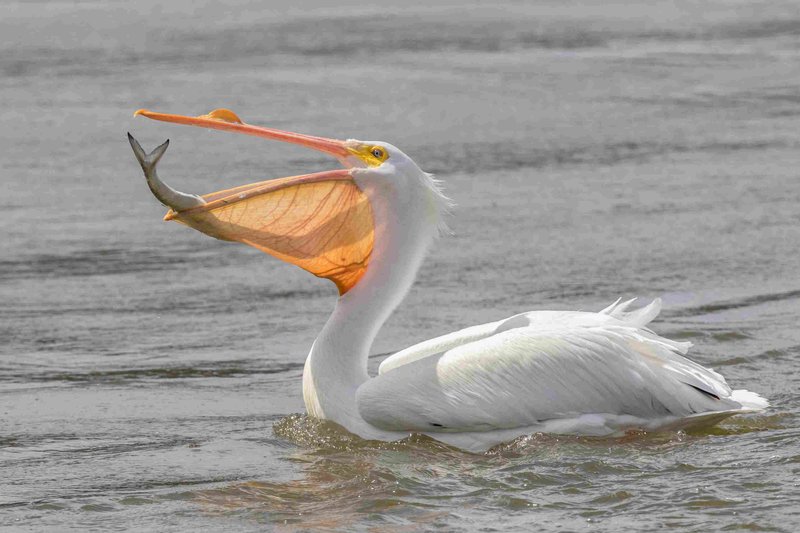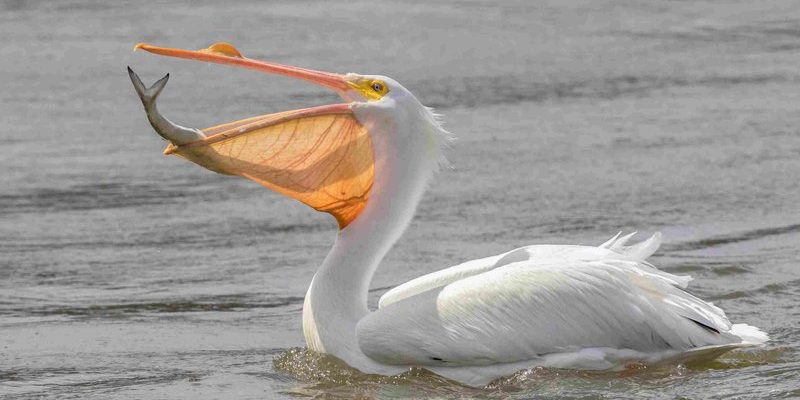
You might see pelicans lounging on a sunny beach or gracefully gliding over water. These birds are found in several parts of the world, thriving in coastal areas, lakes, and rivers. They’re not just pretty faces either—they have some impressive adaptations that help them survive and thrive in their habitats. So, grab a cup of coffee, and let’s explore the intriguing world of pelicans together!
1. Unique Feeding Technique
One of the most fascinating things about pelicans is their hunting style. These birds have a special technique that makes them stand out. Pelicans can be seen diving into the water, using their large, pouch-like bills to catch fish. But here’s the cool part: they’re not just randomly scooping up fish. They actually work together in groups, creating a “fishing net” by driving fish into shallow water.
The pouch of a pelican can hold a surprising amount of fish—up to three gallons! This unique feature allows them to catch more food in one go. After catching their meal, pelicans tilt their heads back to let the water drain out, leaving just the fish behind. It’s like they have their own built-in fish basket!
2. Gorgeous Feather Colors
Pelicans come in several species, and the colors of their feathers can be quite striking. Most have a combination of white, grey, and brown. However, during the breeding season, male brown pelicans develop beautiful, vibrant plumage on their heads and necks, showcasing stunning hues of deep brown and rich green.
These feather colors help attract potential mates. Bright colors in birds often signal health and vitality, which is attractive to females. So, it’s not just about looking good; it’s also about survival and passing on genes.
3. Impressive Wingspan
Speaking of looks, did you know pelicans have an impressive wingspan? Depending on the species, their wings can stretch anywhere from 6 to 10 feet! This incredible wingspan allows them to glide effortlessly over water. Imagine a glider in the sky, gracefully riding warm air currents without a flap.
This ability to soar is essential for searching for food and finding new habitats. Interestingly, their large wings also help them take off and land smoothly, making it easier to maneuver in their environments. When you see a pelican in flight, it’s a reminder of how nature has perfected the art of gliding.
4. Adaptable Habitat
Pelicans are not picky about where they live. They can be found on every continent except Antarctica. From sandy beaches to freshwater lakes, pelicans have adapted to a range of habitats. This adaptability is vital for their survival in changing environments.
They prefer to stay near water sources, where they can hunt for fish, but they also make nests on land or small islands. Their nesting sites are often made of sticks and vegetation, providing safety from predators. Pelicans are excellent at finding just the right spot to call home, making them truly adaptable creatures.
5. Social Birds
If you ever watch a group of pelicans, you’ll notice they’re quite the socialites! These birds often gather in large colonies, especially when it comes to feeding time. They thrive in groups and rely on one another for hunting and safety.
Their social behaviors extend beyond hunting, too. Pelicans can often be seen engaging in playful interactions, from splashing each other in the water to competing for the best fishing spots. This social nature not only strengthens bonds but also enhances their survival chances against predators.
6. Pelican Parenting
When it comes to raising their young, pelicans are dedicated parents. After mating, females lay 3 to 5 eggs, and both parents take turns incubating the eggs. This teamwork is essential for keeping the eggs warm and safe from predators.
Once the chicks hatch, they’re quite helpless at first. Both parents continue to provide food, regurgitating partially digested fish into the chicks’ mouths. It’s a pretty intense parenting method but ensures the little ones get the nutrients they need to grow strong.
7. Threats to Survival
Despite their resilience, pelicans face several threats in the wild. Habitat loss due to pollution, climate change, and human activities impacts their populations. Furthermore, fishing nets and other marine debris can pose dangers, leading to accidental captures or injuries.
Conservation efforts are underway in many regions to protect pelicans and their habitats. By raising awareness about these threats, we can help ensure that these remarkable birds continue to thrive in the wild for generations to come.
8. Symbol of Resilience
Throughout history, pelicans have been seen as symbols of resilience and adaptability. In various cultures, they are often portrayed as nurturing figures, thanks to their dedicated parenting. Their ability to thrive in diverse environments makes them a representation of strength in the face of challenges.
In some traditions, pelicans are even associated with sacrifice, as they’re believed to feed their young with their own flesh in times of need. This powerful image has led to their representation in art and literature across many cultures.
9. Fun Pellet Shooting
Pelicans aren’t just about graceful gliding and fishing—they have a quirky side, too! When a pelican catches a fish, they often need to work hard to swallow it. At times, they’ll shake their heads or even “shoot” the fish out of their beak to reposition it before swallowing.
This amusing behavior can be quite entertaining to watch. It adds a touch of personality to these otherwise serious bird hunters. So next time you see a pelican, keep an eye out for this funny feeding habit!
10. Endearing Curiosity
Finally, one of the most charming aspects of pelicans is their apparent curiosity. They are often seen observing their surroundings, tilting their heads and watching with keen interest. This curious behavior helps them stay alert to potential threats and opportunities for food.
Their inquisitive nature is a reminder that there’s always something new to discover in nature. Whether it’s finding a new fishing spot or interacting with their fellow pelicans, these birds remind us to approach life with a sense of wonder.
As we wrap up our journey through the fascinating world of pelicans, it’s clear they’re not just quirky birds; they’re resilient, social, and downright entertaining. With their incredible adaptations and charming personalities, pelicans continue to be a source of intrigue and admiration. Next time you see one, you might just look at them a little differently!

